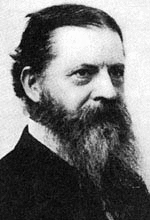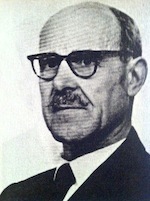Marc Abrahams's Blog, page 578
April 25, 2012
The Egyptian six-hour necrophilia legislation
Necrophilia might soon become specifically legal in Egypt, within specific bounds, according to this report by Abeer Tayel in Al Arabiya News:
Egypt’s women urge MPs not to pass early marriage, sex-after-death laws: report
Egypt’s National Council for Women (NCW) has appealed to the Islamist-dominated parliament not to approve two controversial laws on the minimum age of marriage and allowing a husband to have sex with his dead wife within six hours of her death according to a report in an Egyptian newspaper…. [The controversy] to two laws: one that would legalize the marriage of girls starting from the age of 14 and the other that permits a husband to have sex with his dead wife within the six hours following her death…. Zamzami Abdul Bari [pictured here] said that marriage remains valid even after death adding that a woman also too had the same right to engage in sex with her dead husband.
BONUS: “FATWA: NECROPHILIA IS NOW HALAL IN MOROCCO”
BONUS: This legislation has no exact equivalent in most other countries, as far as we are aware. Here is a report (in a series) about how the necrophilia regulations work in portions of the United States: “Corpse case rises anew, again”
BONUS: One of the few experts on necrophilia law is John Troyer, deputy director of the Centre for Death and Society, at the University of Bath, England.

Eminent space-dinosaurs self-plagiarism headline
Today’s Headline of the Day appears in the Nature newsblog:
Eminent chemist denies self-plagiarism in ‘space dinosaurs’ paper
(HT Ed Yong)

The personal data of Mr. Stephen Wolfram
Stephen Wolfram analyzes some of the data he has been collecting about himself over many years:
But even though I’ve been accumulating data for years—and always meant to analyze it—I’ve never actually gotten around to doing it. But withMathematica and the automated data analysis capabilities we just released in Wolfram|Alpha Pro, I thought now would be a good time to finally try taking a look—and to use myself as an experimental subject for studying what one might call “personal analytics”….
Another kind of data that I’ve been collecting is keystrokes. For many years, I’ve captured every keystroke I’ve typed—now more than 100 million of them:
There are all kinds of detailed facts to extract: like that the average fraction of keys I type that are backspaces has consistently been about 7% (I had no idea it was so high!)….
(Thanks to investigator Ed Pegg for bringing this to our attention.)

Kitchen utensils as medical metaphors

Little fork – Fourchette
In medicine, it’s not only food and drink that are used as analogies. Kitchen utensils also are part of the banquet – an example on this improbable blog was the tumbler test.
Other kitchen ware includes:
Fourchette – little fork (very popular post)
BONUS. A banquet cannot be complete without those who serve food.

April 24, 2012
Recognitions – part 4 – “Sloshing sounds courtesy of…”
The CNBC not only provides a freely available online source of Greebles, Tribbles and Yadgits, (see previous article in this series) but also links to the Auditory Lab at Carnegie Mellon University Psycholgy Department, headed by professor Laurie Heller. The lab hosts a huge archive of carefully produced audio recordings provided for research purposes. Hear here, for example, a selection of high resolution recordings of sloshes (The archives on the site are in .zip format, so for convenience Improbable has transferred an example to a Flash file for easy access.)
We are requested to include this copyright notice: Sloshing sounds courtesy of the Sound Events Database (http://www.auditorylab.org/) Copyright 2008, Laurie M. Heller. Funding provided by NSF award 0446955.
The main categories available at the lab are :
• Impact Events (including ‘Marbles Dropped in Glass Vase’),
• Deformation Events, (including ‘Crush cabbage on board’),
• Rolling Events, (including ‘Tiny Wood Ball on Metal’),
• Air Events, (including ‘Inflating Bike Tube’),
• Liquid Events (including ‘Sloshing’), and
• Experiment Stimuli (including ‘Breaking Spaghetti’),
This concludes Improbable’s short four part season on ‘Recognitions’.

April issue of mini-AIR
 The April issue of mini-AIR just went out. Topics include:
The April issue of mini-AIR just went out. Topics include:
Wine, With or Without Women, and Song
Wine Swirling Limerick Competition
Crumpled-Paper Poets
Upcoming Show in Cambridge
Mousy Smell in Wine
and more
Mel [pictured here] says, “It’s swell.”
(mini-AIR is the simplest way to keep informed about Improbable and Ig Nobel news and events. Just add yourself to the mini-AIR list, and mini-AIR will be emailed to you every month)

Happy 100th to Willcocks of the squared square
 Ed Pegg writes, on the Mattpuzzle site: “T. H. Willcocks [pictured here], the first to make a perfect squared square, turned 100 on 19 April 2012″. Further detail:
Ed Pegg writes, on the Mattpuzzle site: “T. H. Willcocks [pictured here], the first to make a perfect squared square, turned 100 on 19 April 2012″. Further detail:
At WWII end, an able young Englishman became aware of and interested in the problem of squaring the square. This man is Theophilus Harding Willcocks (THW), also known as Phil Willcocks….
THW discovered (in 1946) and subsequently published, a compound perfect squared square with 24 squares, which was for more than 30 years, prior to Duijvestijn’s discovery of 21:112A, the most widely known perfect squared square.
So many authors have cited this square that its figure is well known even to casual readers (with a broad spectrum of interests in mathematics, but unlikely to read the technical papers on the subject). “this little gem of Willcocks”, as it has been called is 24: 175a (THW). For more than three decades, it was the benchmark by which all other squares were measured (as it had the lowest order and smallest side of any known perfect square) and it remains today, the lowest possible order compound perfect square, a fact established by Duijvestijn, P. J. Federico and P. Leeuw in 1982. Even today with conclusive permanent records of the ultra-low-order squares established, only three people have produced a square which betters this square in size and order.
BONUS: Square a square as a piece of furniture

How Exactly Did You Get an Oven Mitt in Your Rectum?
A silicone oven mitt. (NOTE: The oven mitt described in the study was of more traditional design and construction.)
When unusual objects turn up in awkward places, that’s not necessarily the end of the story. A doctor who succumbs to embarrassment or simple amusement — and fails to ask how those objects got there — might overlook a potentially life-threatening injury. Here’s an unusual object lesson:
“Rectal ‘oven mitt’: the importance of considering a serious underlying injury,” Julian E. Losanoff, M.D., Kirien T. Kjossev, M.D., Journal of Emergency Medicine, 17(1), Jan-Feb 1999, pp. 31-3. DOI: 10.1016/S0736-4679(98)00116-4. The authors, from the Department of Emergency Surgery at the Military Medical Academy in Bulgaria, report:
“A 20-year-old man presented with a rectal ‘oven mitt,’ which was removed transanally. Rigid proctosigmoidoscopy revealed no apparent perforation, but subsequent contrast enema using meglumine diatrizoate demonstrated an extraperitoneal rectal perforation, which was probably caused by a wooden stick used to forcefully introduce the glove through the patient’s anus. Thus, rectal injuries may be caused not by the foreign object itself, but by another object used as an introducer.”
BONUS: The TV show “Scrubs” once featured a somewhat different object in the same situation. Here are the relevant scenes:

April 23, 2012
The problem of exploding pacemakers
People muse that they will, come the day, “go out with a bang”. A little more often than you might expect, someone or other does exactly that, which is why there came into existence a study called Pacemaker Explosions in Crematoria: Problems and Possible Solutions.
 Christopher Gale [pictured here], of St James’s University Hospital in Leeds, and Graham Mulley, of the General Infirmary at Leeds, published the report in 2002 in the Journal of the Royal Society of Medicine.
Christopher Gale [pictured here], of St James’s University Hospital in Leeds, and Graham Mulley, of the General Infirmary at Leeds, published the report in 2002 in the Journal of the Royal Society of Medicine.
The first crematorium pacemaker explosion on record happened in 1976 in Solihull, in the West Midlands. As pacemakers and cremations both became popular, Gale and Mulley explain, after-death explosions came to be expected.
In the wake of the Solihull surprise, the British Medical Journal published an essay called Hidden Hazards of Cremation…
So begins this week’s Improbable Research column in The Guardian.

April 12, 2012
To sleep, perchance to smell, perchance to create, maybe
One might, maybe inaccurately, sum up this new study by saying, "Put this in your pipe and sleep on it". The study is:
"Good morning creativity: task reactivation during sleep enhances beneficial effect of sleep on creative performance," Simone Ritter, Madelijn Strick, Maarten Bos, Rick Van Baaren, Ap Dijksterhuis [pictured here], Journal of Sleep Research, epub March 9, 2012. The authors, at Radboud University Nijmegen, the Netherlands and at Harvard Business School, Boston, USA, explain:
"Individuals' creative performance was compared after three different conditions: sleep-with-conditioned-odor; sleep-with-control-odor; or sleep-with-no-odor. In the evening prior to sleep, all participants were presented with a problem that required a creative solution. In the two odor conditions, a hidden scent-diffuser spread an odor while the problem was presented…. After a night of sleep with the conditioned odor, participants were found to be: (i) more creative; and (ii) better able to select their most creative idea than participants who had been exposed to a control odor or no odor while sleeping."
(Thanks to investigator Carmen Nobel for bringing this to our attention.)

Marc Abrahams's Blog
- Marc Abrahams's profile
- 14 followers

























